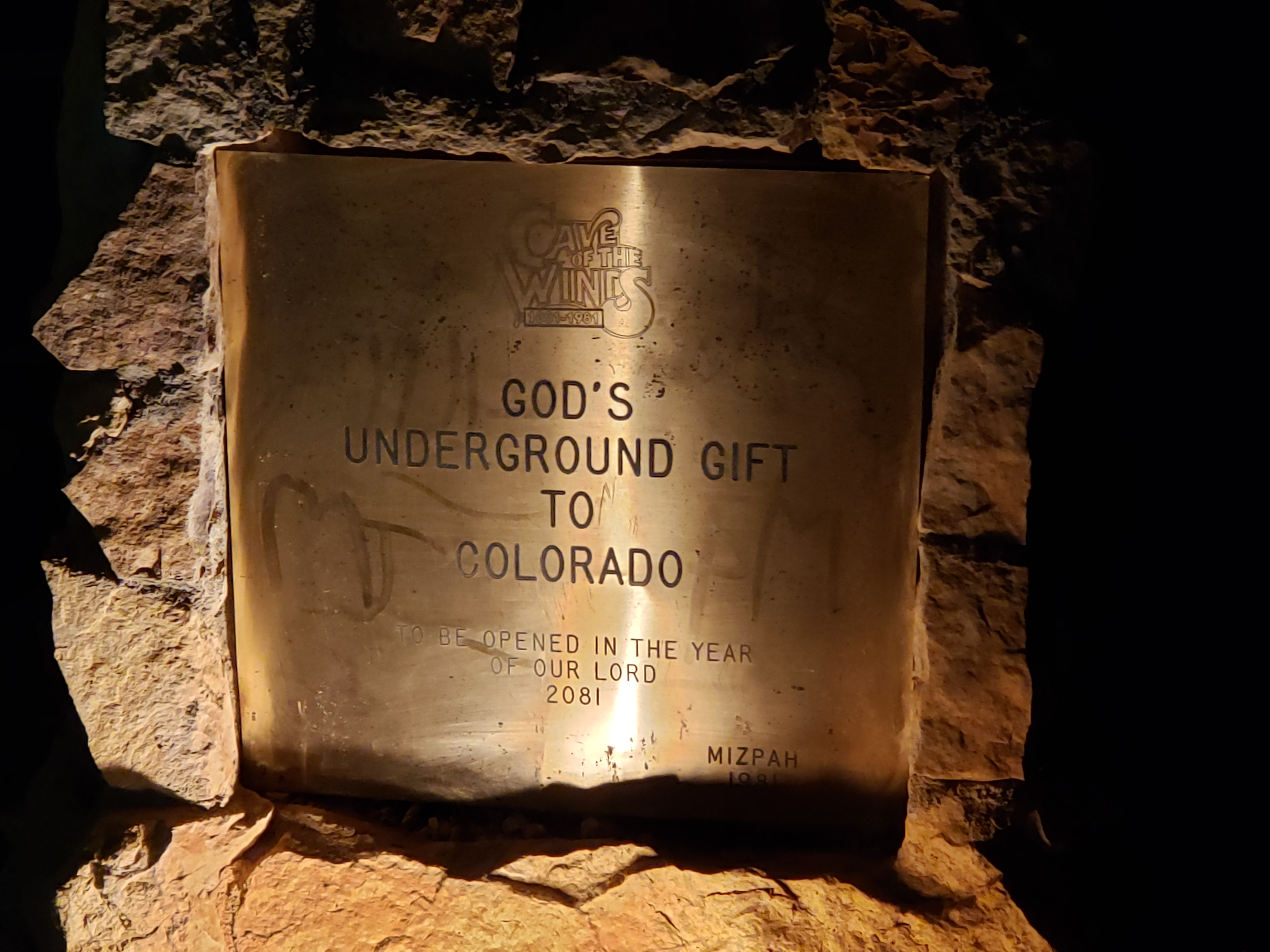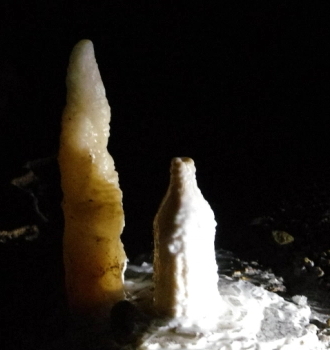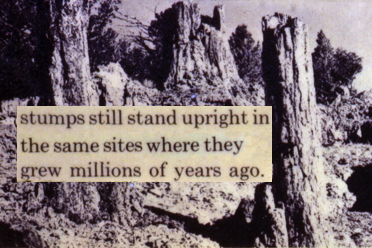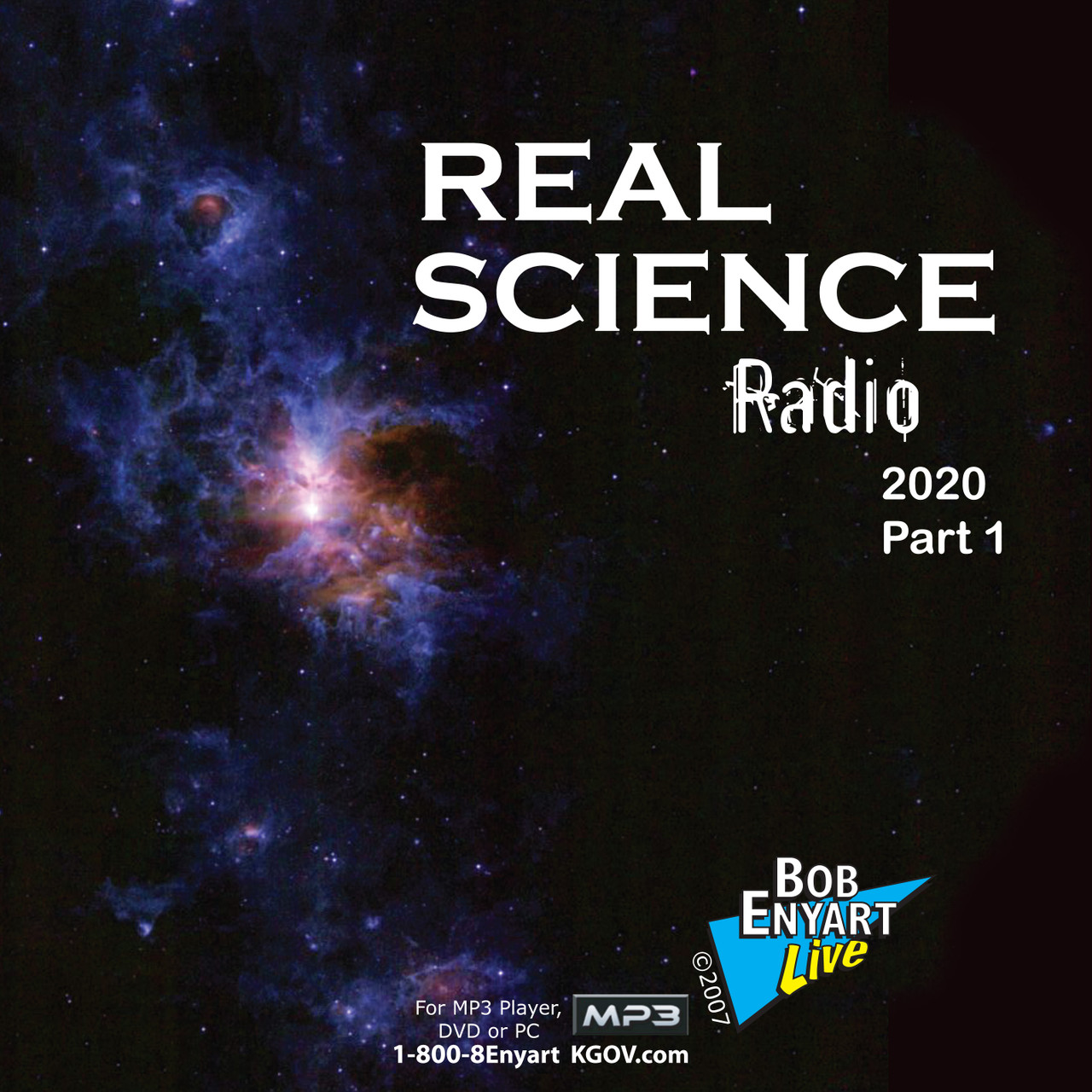RSR'S Timesaving Google Creation Tool: Multiple Creation Site Search !
Welcome to Real Science Radio: Co-hosts Fred Williams and Doug McBurney talk about science to debunk evolution and to show the evidence for the creator God including from biology, genetics, geology, history, paleontology, archaeology, astronomy, philosophy, cosmology, math, and physics. (For example, mutations will give you bad legs long before you'd get good wings.) We get to debate Darwinists and atheists like Lawrence Krauss, AronRa, and Eugenie Scott. We easily take potshots from popular evolutionists like PZ Myers, Phil Plait, and Jerry Coyne. The RSR Archive contains our popular List Shows! And we interview the outstanding scientists who dare to challenge today's accepted creed that nothing created everything.
RSR airs every Friday at 12:30pm MST on AM 670 KLTT in Denver, Colorado. For rebroadcast times and podcast platforms, see our Affiliates page.
⇒ SPONSOR A SHOW!
Its the Hydroplate Week of Celebration! For details, visit hydroplate.org
RSR's Behind-the-Scenes Guy Brian Lauer in for Fred Williams
 With Real Science Radio co-host Fred Williams on assignment out of state, Bob Enyart interviews Brian Lauer, the creation activist making a difference (here at RSR and) on the campus of Saint Cloud State University in Minnesota. When Fred returns, the guys will do as promised, Lord-willing, and discuss their rsr.org/one-way-speed-of-light measurement proposal. And... why not, in a separate program regarding the iconic quantum mechanics two-slit experiment getting the results it does (wave/particle duality and the waveform collapsing upon observation/recording/
With Real Science Radio co-host Fred Williams on assignment out of state, Bob Enyart interviews Brian Lauer, the creation activist making a difference (here at RSR and) on the campus of Saint Cloud State University in Minnesota. When Fred returns, the guys will do as promised, Lord-willing, and discuss their rsr.org/one-way-speed-of-light measurement proposal. And... why not, in a separate program regarding the iconic quantum mechanics two-slit experiment getting the results it does (wave/particle duality and the waveform collapsing upon observation/recording/
How the Flesh is like Gravity
 * RSR'S Timesaving Google Creation Tool: Multiple Creation Site Search!
* RSR'S Timesaving Google Creation Tool: Multiple Creation Site Search!
* The Flesh: Just as universal gravitation affects our physical universe, the world (system) and our flesh attract one another and affect our spiritual lives. While two families, Bob Enyart's and Doug McBurney's, spend a couple days in Manitou Springs summiting a mountain, ziplining down, and exploring a cave, we've reaching into our archives to present this program which we're calling a special episode of Real Science Radio!

* Trading Genesis: Check out Bob Enyart's theistic evolution presentation in Malibu:
Stretch Cosmology to the One-Way Speed of Light
AN RSR GOOGLE CREATION TOOL: The time-saving multiple creation-site search!
Real Science Radio hosts Bob Enyart and Fred Williams discuss the scientific world's measurement of the roundtrip speed of light with Einstein pointing out the inability of physicists to measure the one-way speed. The guys compare those who claim to have measured light's one-way speed to those who claim to have manufactured a perpetual motion machine. Yet with fear and trepidation, they've been asking themselves whether or not they should publicly propose an experiment to measure the one-way speed of light using brand new technology the likes of which Einstein (and even almost all current scientists) would never have dreamed could be possible. But before getting to that, the guys reminisce about their radio program from 2011 and the written material on its page at rsr.org/stretch, where for the last couple of years they've hidden in plain view their proposed experiment (shhh, don't tell anyone) to measure the one-way speed of light.
A dinosaur sitting on her preserved 24 eggs gets fossilized FAST!
* Time-Saving Google Creation Tool: Multiple Creation Site Search!
* Science News RSR Style: Real Science Radio hosts Bob Enyart and Fred Williams share observations from secular science sources, from Psalm 139, and from MendelsAccountant.com! Also, the guys pull off a neat trick. During today's program they update LAST WEEK's broadcast! :) And finally, about the fabulous dramatized television series on the life of Jesus called The Chosen, Bob and Fred disclose, well, almost, a fun BEL insider project to help promote the production!
RSR's List of Not So Old Things
 [While Bob & Cheryl Enyart go fishing we invite you to enjoy from the RSR archives our favorite List of Not So Old Things! Photos from today, June 25, 2021.]
[While Bob & Cheryl Enyart go fishing we invite you to enjoy from the RSR archives our favorite List of Not So Old Things! Photos from today, June 25, 2021.]
-- Finches Diversify in Decades, Opals Form in Months, Man's Genetic Diversity in 200 Generations, C-14 Everywhere: Real Science Radio hosts Bob Enyart and Fred Williams present their classic program that led to the audience-favorites rsr.org/list-shows! See below and hear on today's radio program our list of Not So Old and Not So Slow Things! From opals forming in months to man's genetic diversity in 200 generations, and with carbon 14 everywhere it's not supposed to be (including in diamonds and dinosaur bones!), scientific observations fill the guys' most traditional list challenging those who claim that the earth is billions of years old. Many of these scientific finds demand a re-evaluation of supposed million and billion-year ages.
 * Finches Adapt in 17 Years, Not 2.3 Million: Charles Darwin's finches are claimed to have taken 2,300,000 years to diversify from an initial species blown onto the Galapagos Islands. Yet individuals from a single finch species on a U.S. Bird Reservation in the Pacific were introduced to a group of small islands 300 miles away and in at most 17 years, like Darwin's finches, they had diversified their beaks, related muscles, and behavior to fill various ecological niches. Hear about this also at rsr.org/spetner.
* Finches Adapt in 17 Years, Not 2.3 Million: Charles Darwin's finches are claimed to have taken 2,300,000 years to diversify from an initial species blown onto the Galapagos Islands. Yet individuals from a single finch species on a U.S. Bird Reservation in the Pacific were introduced to a group of small islands 300 miles away and in at most 17 years, like Darwin's finches, they had diversified their beaks, related muscles, and behavior to fill various ecological niches. Hear about this also at rsr.org/spetner.
 * Opals Can Form in "A Few Months" And Don't Need 100,000 Years: A leading authority on opals, Allan W. Eckert, observed that, "scientific papers and textbooks have told that the process of opal formation requires tens of thousands of years, perhaps hundreds of thousands... Not true." A 2011 peer-reviewed paper in a geology journal from Australia, where almost all the world's opal is found, reported on the: "new timetable for opal formation involving weeks to a few months and not the hundreds of thousands of years envisaged by the conventional weathering model." (And apparently, per a 2019 report from Entomology Today, opals can even form around insects!) More knowledgeable scientists resist the uncritical, group-think insistence on false super-slow formation rates (as also for manganese nodules, gold veins, stone, petroleum, canyons and gullies, and even guts, all below). Regarding opals, Darwinian bias led geologists to long ignore possible quick action, as from microbes, as a possible explanation for these mineraloids. For both in nature and in the lab, opals form rapidly, not even in 10,000 years, but in weeks. See this also from creationists by a geologist, a paleobiochemist, and a nuclear chemist.
* Opals Can Form in "A Few Months" And Don't Need 100,000 Years: A leading authority on opals, Allan W. Eckert, observed that, "scientific papers and textbooks have told that the process of opal formation requires tens of thousands of years, perhaps hundreds of thousands... Not true." A 2011 peer-reviewed paper in a geology journal from Australia, where almost all the world's opal is found, reported on the: "new timetable for opal formation involving weeks to a few months and not the hundreds of thousands of years envisaged by the conventional weathering model." (And apparently, per a 2019 report from Entomology Today, opals can even form around insects!) More knowledgeable scientists resist the uncritical, group-think insistence on false super-slow formation rates (as also for manganese nodules, gold veins, stone, petroleum, canyons and gullies, and even guts, all below). Regarding opals, Darwinian bias led geologists to long ignore possible quick action, as from microbes, as a possible explanation for these mineraloids. For both in nature and in the lab, opals form rapidly, not even in 10,000 years, but in weeks. See this also from creationists by a geologist, a paleobiochemist, and a nuclear chemist.
* Finches Speciate in Two Generations vs Two Million Years for Darwin's Birds? Darwin's finches on the Galapagos Islands are said to have diversified into 14 species over a period of two million years. But in 2017 the journal Science reported a newcomer to the Island which within two generations spawned a reproductively isolated new species. In another instance as documented by Lee Spetner, a hundred birds of the same finch species introduced to an island cluster a 1,000 kilometers from Galapagos diversified into species with the typical variations in beak sizes, etc. "If this diversification occurred in less than seventeen years," Dr. Spetner asks, "why did Darwin’s Galapagos finches [as claimed by evolutionists] have to take two million years?"
 * Blue Eyes Originated Not So Long Ago: Not a million years ago, nor a hundred thousand years ago, but based on a peer-reviewed paper in Human Genetics, a press release at Science Daily reports that, "research shows that people with blue eyes have a single, common ancestor. A team at the University of Copenhagen have tracked down a genetic mutation which took place 6-10,000 years ago and is the cause of the eye colour of all blue-eyed humans alive on the planet today."
* Blue Eyes Originated Not So Long Ago: Not a million years ago, nor a hundred thousand years ago, but based on a peer-reviewed paper in Human Genetics, a press release at Science Daily reports that, "research shows that people with blue eyes have a single, common ancestor. A team at the University of Copenhagen have tracked down a genetic mutation which took place 6-10,000 years ago and is the cause of the eye colour of all blue-eyed humans alive on the planet today."
* Adding the Entire Universe to our List of Not So Old Things? Based on March 2019 findings from Hubble, Nobel laureate Adam Riess of the Space Telescope Science Institute and his co-authors in the Astrophysical Journal estimate that the universe is about a billion years younger than previously thought! Then in September 2019 in the journal Science, the age dropped precipitiously to as low as 11.4 billion years! Of course, these measurements also further squeeze the canonical story of the big bang chronology with its many already existing problems including the insufficient time to "evolve" distant mature galaxies, galaxy clusters, superclusters, enormous black holes, filaments, bubbles, walls, and other superstructures. So, even though the latest estimates are still absurdly too old (Google: big bang predictions, and click on the #1 ranked article, or just go on over there to rsr.org/bb), regardless, we thought we'd plop the whole universe down on our List of Not So Old Things!
 * After the Soft Tissue Discoveries, NOW Dino DNA: When a North Carolina State University paleontologist took the Tyrannosaurus Rex photos to the right of original biological material, that led to the 2016 discovery of dinosaur DNA, So far researchers have also recovered dinosaur blood vessels, collagen, osteocytes, hemoglobin, red blood cells, and various proteins.
* After the Soft Tissue Discoveries, NOW Dino DNA: When a North Carolina State University paleontologist took the Tyrannosaurus Rex photos to the right of original biological material, that led to the 2016 discovery of dinosaur DNA, So far researchers have also recovered dinosaur blood vessels, collagen, osteocytes, hemoglobin, red blood cells, and various proteins.
 As of May 2018, twenty-six scientific journals, including Nature, Science, PNAS, PLoS One, Bone, and Journal of Vertebrate Paleontology, have confirmed the discovery of biomaterial fossils from many dinosaurs! Organisms including T. Rex, hadrosaur, titanosaur, triceratops, Lufengosaur, mosasaur, and Archaeopteryx, and many others dated, allegedly, even hundreds of millions of years old, have yielded their endogenous, still-soft biological material. See the web's most complete listing of 100+ journal papers (screenshot, left) announcing these discoveries at bflist.rsr.org and see it in layman's terms at rsr.org/soft.
As of May 2018, twenty-six scientific journals, including Nature, Science, PNAS, PLoS One, Bone, and Journal of Vertebrate Paleontology, have confirmed the discovery of biomaterial fossils from many dinosaurs! Organisms including T. Rex, hadrosaur, titanosaur, triceratops, Lufengosaur, mosasaur, and Archaeopteryx, and many others dated, allegedly, even hundreds of millions of years old, have yielded their endogenous, still-soft biological material. See the web's most complete listing of 100+ journal papers (screenshot, left) announcing these discoveries at bflist.rsr.org and see it in layman's terms at rsr.org/soft.
* Rapid Stalactites, Stalagmites, Etc.: A construction worker in 1954 left a lemonade bottle in one of Australia's famous Jenolan Caves. By 2011 it had been naturally transformed into a stalagmite (below, right). Increasing scientific knowledge is arguing for rapid cave formation (see below, Nat'l Park Service shrinks Carlsbad Caverns formation estimates from 260M years, to 10M, to 2M, to it "depends"). Likewise, examples are growing of rapid formations with typical chemical make-up (see bottle, left) of classic stalactites and stalagmites including: - in Nat'l Geo the Carlsbad Caverns stalagmite that rapidly covered a bat
- in Nat'l Geo the Carlsbad Caverns stalagmite that rapidly covered a bat
- the tunnel stalagmites at Tennessee's Raccoon Mountain
- hundreds of stalactites beneath the Lincoln Memorial
- those near Gladfelter Hall at Philadelphia's Temple University (send photos to Bob@rsr.org)
- hundreds of stalactites at Australia's zinc mine at Mt. Isa.
- and those beneath Melbourne's Shrine of Remembrance.
* Most Human Mutations Arose in 200 Generations: From Adam until Real Science Radio, in only 200 generations! The journal Nature reports The Recent Origin of Most Human Protein-coding Variants. As summarized by geneticist co-author Joshua Akey, "Most of the mutations that we found arose in the last 200 generations or so" (the same number previously published by biblical creationists). Another 2012 paper, in the American Journal of Physical Anthropology (Eugenie Scott's own field) on High mitochondrial mutation rates, shows that one mitochondrial DNA mutation occurs every other generation, which, as creationists point out, indicates that mtEve would have lived about 200 generations ago. That's not so old!
 * National Geographic's Not-So-Old Hard-Rock Canyon at Mount St. Helens: As our List of Not So Old Things (this web page) reveals, by a kneejerk reaction evolutionary scientists assign ages of tens or hundreds of thousands of years (or at least just long enough to contradict Moses' chronology in Genesis.) However, with closer study, routinely, more and more old ages get revised downward to fit the world's growing scientific knowledge. So the trend is not that more information lengthens ages, but rather, as data replaces guesswork, ages tend to shrink until they are consistent with the young-earth biblical timeframe. Consistent with this observation, the May 2000 issue of National Geographic quotes the U.S. Forest Service's scientist at Mount St. Helens, Peter Frenzen, describing the canyon on the north side of the volcano. "You'd expect a hard-rock canyon to be thousands, even hundreds of thousands of years old. But this was cut in less than a decade." And as for the volcano itself, while again, the kneejerk reaction of old-earthers would be to claim that most geologic features are hundreds of thousands or millions of years old, the atheistic National Geographic magazine acknowledges from the evidence that Mount St. Helens, the volcanic mount, is only about 4,000 years old! See below and more at rsr.org/mount-st-helens.
* National Geographic's Not-So-Old Hard-Rock Canyon at Mount St. Helens: As our List of Not So Old Things (this web page) reveals, by a kneejerk reaction evolutionary scientists assign ages of tens or hundreds of thousands of years (or at least just long enough to contradict Moses' chronology in Genesis.) However, with closer study, routinely, more and more old ages get revised downward to fit the world's growing scientific knowledge. So the trend is not that more information lengthens ages, but rather, as data replaces guesswork, ages tend to shrink until they are consistent with the young-earth biblical timeframe. Consistent with this observation, the May 2000 issue of National Geographic quotes the U.S. Forest Service's scientist at Mount St. Helens, Peter Frenzen, describing the canyon on the north side of the volcano. "You'd expect a hard-rock canyon to be thousands, even hundreds of thousands of years old. But this was cut in less than a decade." And as for the volcano itself, while again, the kneejerk reaction of old-earthers would be to claim that most geologic features are hundreds of thousands or millions of years old, the atheistic National Geographic magazine acknowledges from the evidence that Mount St. Helens, the volcanic mount, is only about 4,000 years old! See below and more at rsr.org/mount-st-helens.
* Mount St. Helens Dome Ten Years Old not 1.7 Million: Geochron Laboratories of Cambridge, Mass., using potassium-argon and other radiometric techniques claims the rock sample they dated, from the volcano's dome, solidified somewhere between 340,000 and 2.8 million years ago. However photographic evidence and historical reports document the dome's formation during the 1980s, just ten years prior to the samples being collected. With the age of this rock known, radiometric dating therefore gets the age 99.99999% wrong.
 * Devils Hole Pupfish Isolated Not for 13,000 Years But for 100: Secular scientists default to knee-jerk, older-than-Bible-age dates. However, a tiny Mojave desert fish is having none of it. Rather than having been genetically isolated from other fish for 13,000 years (which would make this small school of fish older than the Earth itself), according to a paper in the journal Nature, actual measurements of mutation rates indicate that the genetic diversity of these Pupfish could have been generated in about 100 years, give or take a few.
* Devils Hole Pupfish Isolated Not for 13,000 Years But for 100: Secular scientists default to knee-jerk, older-than-Bible-age dates. However, a tiny Mojave desert fish is having none of it. Rather than having been genetically isolated from other fish for 13,000 years (which would make this small school of fish older than the Earth itself), according to a paper in the journal Nature, actual measurements of mutation rates indicate that the genetic diversity of these Pupfish could have been generated in about 100 years, give or take a few.
 * Polystrates like Spines and Rare Schools of Fossilized Jellyfish: Previously, seven sedimentary layers in Wisconsin had been described as taking a million years to form. And because jellyfish have no skeleton, as Charles Darwin pointed out, it is rare to find them among fossils. But now, reported in the journal Geology, a school of jellyfish fossils have been found throughout those same seven layers. So, polystrate fossils that condense the time of strata deposition from eons to hours or months, include:
* Polystrates like Spines and Rare Schools of Fossilized Jellyfish: Previously, seven sedimentary layers in Wisconsin had been described as taking a million years to form. And because jellyfish have no skeleton, as Charles Darwin pointed out, it is rare to find them among fossils. But now, reported in the journal Geology, a school of jellyfish fossils have been found throughout those same seven layers. So, polystrate fossils that condense the time of strata deposition from eons to hours or months, include:
- Jellyfish in central Wisconsin were not deposited and fossilized over a million years but during a single event quick enough to trap a whole school. (This fossil school, therefore, taken as a unit forms a polystrate fossil.) Examples are everywhere that falsify the claims of strata deposition over millions of years.
- Countless trilobites buried in astounding three dimensionality around the world are meticulously recovered from limestone, much of which is claimed to have been deposited very slowly. Contrariwise, because these specimens were buried rapidly in quickly laid down sediments, they show no evidence of greater erosion on their upper parts as compared to their lower parts. - The delicacy of radiating spine polystrates, like tadpole and jellyfish fossils, especially clearly demonstrate the rapidity of such strata deposition.
- The delicacy of radiating spine polystrates, like tadpole and jellyfish fossils, especially clearly demonstrate the rapidity of such strata deposition.
- A second school of jellyfish, even though they rarely fossilized, exists in another locale with jellyfish fossils in multiple layers, in Australia's Brockman Iron Formation, constraining there too the rate of strata deposition. By the way, jellyfish are an example of evolution's big squeeze. Like galaxies evolving too quickly, galaxy clusters, and even human feet (which, like Mummy DNA, challenge the Out of Africa paradigm), jellyfish have gotten into the act squeezing evolution's timeline, here by 200 million years when they were found in strata allegedly a half-a-billion years old. Other examples, ironically referred to as Medusoid Problematica, are even found in pre-Cambrian strata.
- 171 tadpoles of the same species buried in diatoms.
- Leaves buried vertically through single-celled diatoms powerfully refute the claimed super-slow deposition of diatomaceous rock.
- Many fossils, including a Mesosaur, have been buried in multiple "varve" layers, which are claimed to be annual depositions, yet they show no erosional patterns that would indicate gradual burial (as they claim, absurdly, over even thousands of years).
- A single whale skeleton preserved in California in dozens of layers of diatom deposits thus forming a polystrate fossil.
- 40 whales buried in the desert in Chile. "What's really interesting is that this didn't just happen once," said Smithsonian evolutionist Dr. Nick Pyenson. It happened four times." Why's that? Because "the fossil site has at least four layers", to which Real Science Radio's Bob Enyart replies: "Ha ha ha ha ha ha ha ha ha ha ha", with RSR co-host Fred Williams thoughtfully adding, "Ha ha!"
 * Polystrate Trees: Examples abound around the world of polystrate trees:
* Polystrate Trees: Examples abound around the world of polystrate trees:
- Yellowstone's petrified polystrate forest (with the NPS exhibit sign removed; see below) with successive layers of rootless trees demonstrating the rapid deposition of fifty layers of strata.
- A similarly formed polystrate fossil forest in France demonstrating the rapid deposition of a dozen strata.
- In a thousand locations including famously the Fossil Cliffs of Joggins, Nova Scotia, polystrate fossils such as trees span many strata.
- These trees lack erosion: Not only should such fossils, generally speaking, not even exist, but polystrates including trees typically show no evidence of erosion increasing with height. All of this powerfully disproves the claim that the layers were deposited slowly over thousands or millions of years. In the experience of your RSR radio hosts, evolutionists commonly respond to this hard evidence with mocking. See CRSQ June 2006, ICR Impact #316, and RSR 8-11-06 at KGOV.com.
 * Yellowstone Petrified Trees Sign Removed: The National Park Service removed their incorrect sign (see left and more). The NPS had claimed that in dozens of different strata over a 40-square mile area, many petrified trees were still standing where they had grown. The NPS eventually removed the sign partly because those petrified trees had no root systems, which they would have had if they had grown there. Instead, the trees of this "fossil forest" have roots that are abruptly broken off two or three feet from their trunks. If these mature trees actually had been remnants of sequential forests that had grown up in strata layer on top of strata layer, 27 times on Specimen Ridge (and 50 times at Specimen Creek), such a natural history implies passage of more time than permitted by biblical chronology. So, don't trust the National Park Service on historical science because they're wrong on the age of the Earth.
* Yellowstone Petrified Trees Sign Removed: The National Park Service removed their incorrect sign (see left and more). The NPS had claimed that in dozens of different strata over a 40-square mile area, many petrified trees were still standing where they had grown. The NPS eventually removed the sign partly because those petrified trees had no root systems, which they would have had if they had grown there. Instead, the trees of this "fossil forest" have roots that are abruptly broken off two or three feet from their trunks. If these mature trees actually had been remnants of sequential forests that had grown up in strata layer on top of strata layer, 27 times on Specimen Ridge (and 50 times at Specimen Creek), such a natural history implies passage of more time than permitted by biblical chronology. So, don't trust the National Park Service on historical science because they're wrong on the age of the Earth.
A proton's data record points to a data table or God's memory?
 Real Science Radio hosts Bob Enyart and Fred Williams end today's program by building upon the quantum mechanics hypothesis the guys proposed last year based on the widespread notion in the world of physics that matter itself may be information based, that is, non-physical. See this at rsr.org/list-of-things-that-
Real Science Radio hosts Bob Enyart and Fred Williams end today's program by building upon the quantum mechanics hypothesis the guys proposed last year based on the widespread notion in the world of physics that matter itself may be information based, that is, non-physical. See this at rsr.org/list-of-things-that-
 Regarding the quantum information packet (i.e., the quip, or the data record) of the helium atom, because of God's remembrance of the values that combine to form that element, the pointers in each atom's "record" dereference to resolve its dimensions and forces. That's how God created the Heavens and the Earth. Fast forward from then to just before He creates the New Heaven and New Earth. 2 Peter 3:10 informs us that the heavens will pass away and the elements will melt with fervent heat and the Earth will be burned up. This happens by God thinking a higher value for a proton's charge.
Regarding the quantum information packet (i.e., the quip, or the data record) of the helium atom, because of God's remembrance of the values that combine to form that element, the pointers in each atom's "record" dereference to resolve its dimensions and forces. That's how God created the Heavens and the Earth. Fast forward from then to just before He creates the New Heaven and New Earth. 2 Peter 3:10 informs us that the heavens will pass away and the elements will melt with fervent heat and the Earth will be burned up. This happens by God thinking a higher value for a proton's charge.
Today's Resource: Get all of our 2020 Real Science Radio shows on two MP3 discs!
Neanderthal Burial: Another Nail in Darwin's Coffin
 Real Science Radio hosts Bob Enyart and Fred Williams present the latest Creation Magazine science news reports including that Neanderthals buried their dead, used the same tool technology as the other human beings in their day used, heard and spoke just like modern men, and frequently interbred with other early humans as, for example, Americans and Brits do today. The guys also discussed NASA's message on the Mars rover landing parachute, the delicate vegetation beneath Greenland's ice sheet that looks like it "died yesterday", and, most stunning of all, the 3D twisting and looping of the DNA strand that not only brings together "distant" related genes, but can help scientists diagnose, and hopefully treat, pediatric brain tumor patients.
Real Science Radio hosts Bob Enyart and Fred Williams present the latest Creation Magazine science news reports including that Neanderthals buried their dead, used the same tool technology as the other human beings in their day used, heard and spoke just like modern men, and frequently interbred with other early humans as, for example, Americans and Brits do today. The guys also discussed NASA's message on the Mars rover landing parachute, the delicate vegetation beneath Greenland's ice sheet that looks like it "died yesterday", and, most stunning of all, the 3D twisting and looping of the DNA strand that not only brings together "distant" related genes, but can help scientists diagnose, and hopefully treat, pediatric brain tumor patients.
Trees Talk. Really! (Well, not REALLY, but... Really!)
 Like a thermostat talking to the furnace, trees talk to one another, and even to the neighbors' furnaces, so to speak, and by the analogy, to many other devices. Bob Enyart and Fred Williams highlight Real Science Radio's existing reports at rsr.org/trees including on tree-ring dating and how seeds know which way is up and which is down (their cells produce an anchor that sinks so they can shoot up their stems in the opposite direction). The guys then review forest expert Tom Hennigan's report for Answers in Genesis on trees reproducing the saliva of attacking beetles to attract predators to come and get the beetles, and how for a sapling other trees will pull back their roots, and how in some species when one tree is diseased other trees will give up nutrients in hopes of nursing the sick tree back to health.
Like a thermostat talking to the furnace, trees talk to one another, and even to the neighbors' furnaces, so to speak, and by the analogy, to many other devices. Bob Enyart and Fred Williams highlight Real Science Radio's existing reports at rsr.org/trees including on tree-ring dating and how seeds know which way is up and which is down (their cells produce an anchor that sinks so they can shoot up their stems in the opposite direction). The guys then review forest expert Tom Hennigan's report for Answers in Genesis on trees reproducing the saliva of attacking beetles to attract predators to come and get the beetles, and how for a sapling other trees will pull back their roots, and how in some species when one tree is diseased other trees will give up nutrients in hopes of nursing the sick tree back to health.
Today's Resource:
Get all of our 2020 Real Science Radio shows on two MP3 discs!
God, Science, and Savants Pt. 2
* Here's How Savant Syndrome Occurs: Real Science Radio hosts Bob Enyart and Fred Williams have corrected and expanded the definition of "savant" and have explained conceptually how the savant syndrome occurs. The secular world is uncomfortable with savants because of what their condition suggests, as discussed on today's broadcast. Hear also a clip from a documentary about Kim Peek, the model for the Rain Man character played by Dustin Hoffman. And the guys present the corrected meaning of the word savant from rsr.org/definitions: a person with a physiological break in the barrier that formed after Man's Fall, that break opening partial access through the barricade designed to block access to our greatest intellectual potential. Hear also a news report about a slingshot savant, Rufus Hussy, who like Annie Oakley, almost never misses and hits quarters out of the air, bugs without damaging the leaves they're sitting on, and can slice tall weeds to fall, as requested, to the right or left. Finally, to give more context to understand their expanded definition of savant, the guys share audio from neuroscience professor Dr. Michael Egnor presenting scientific evidence for dualism, that the mind is not the brain, but that these are distinct entities with the mind not being physical.
* See Also:
- rsr.org/brain-dead-patients-
- rsr.org/savants (part 1 of this 2-part series)
rsr.org/savants (part 1 of this 2-part series)
- rsr.org/mri (RSR friend invented the MRI)
- rsr.org/not-physical#mind
Today’s Resource: Whatever happened to the Tree of the Knowledge of Good and Evil? The answer is fascinating and can be found in this fun and amazingly educational 3-part video. Available on DVD (and audio download or MP3 CD).


